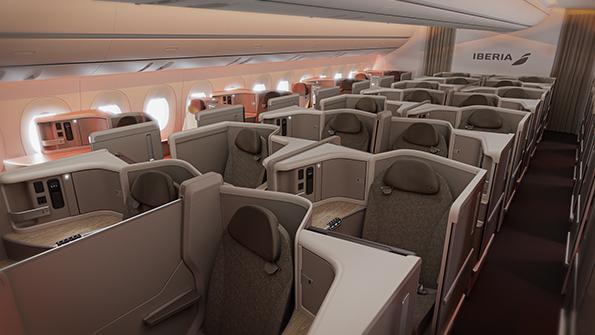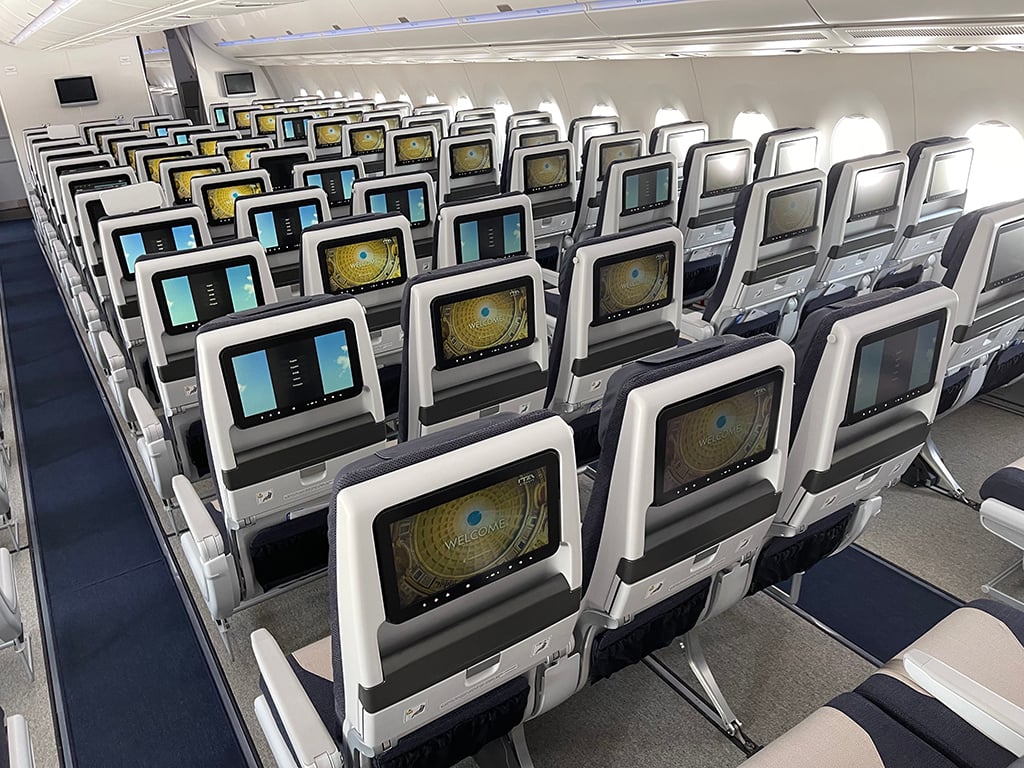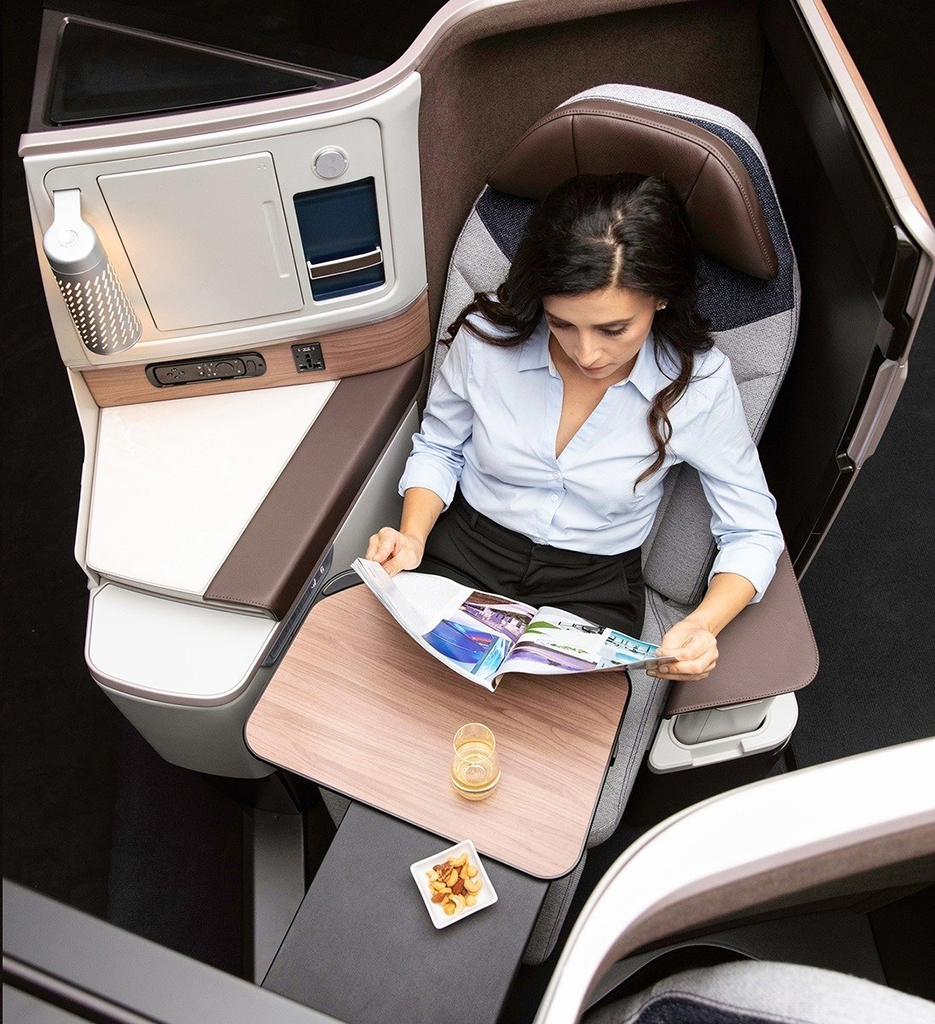Aircraft Seating Aftermarket Drives OEM Competition

Aircraft seat OEMs are increasingly offering refurbishment and repair services in-house.
Cabin interiors MRO is seeing a burst of activity as multiple macro and micro trends motivate airlines to refit aircraft with new seats and cabins. Within this segment, the airline seat market—and its secondhand aftermarket—are often viewed as strongly interlinked sides of the same coin.
One side of the coin features seat OEMs such as Recaro Aircraft Seating, the market leader in economy-class seating, which is the most extensively produced—and refurbished—of the onboard products within the industry. On the other side are seat MRO and refurbishment specialists such as Aviationscouts, which buys older seats as they exit fleets, overhauls them and then sells them to their next operator or aircraft lessor.
Flip that coin again, and it comes back up with the OEMs, which are increasingly offering seat refurbishment and MRO services themselves. For example, Recaro’s latest headquarters expansion includes an in-and-out services business to either return seats to the same airline or transition them onward to another.
Supply Chain Issues
One key driver in the interiors segment is the shortage of spare parts, driven in large part by the wider supply chain issues that aviation has been experiencing over the past few years.

“Due to the shortage of spare parts in the industry, we see a trend to part off seats and use these recertified parts for the refurbishment of other shipsets in the fleet,” says Thomas Bulirsch, CEO of Aviationscouts. “The trend is sustainable, cost-effective and shortens the turnaround time for a refurbishment tremendously.”
To secure adequate supplies of spare parts, “we always buy larger numbers of shipsets to cannibalize them to complete our OEM spare part requirements for the refurbishment,” Bulirsch says. “This trend does not only relate to seats—but also interiors.”
In the pre-pandemic era, more airlines taking an aftermarket aircraft were content to use aftermarket seats, with branding and cabin identity only a distant consideration. This remains the case in some markets, but even some airlines that previously would have been satisfied with refurbished seats are now going directly to seat OEMs.
In 2019, Allegiant Air CEO Maury Gallagher reportedly said to a room of airport executives that Allegiant’s passengers “don’t give a damn about your airports, nor do they give a damn about the interior of my airplanes.” This may have been the case to some extent for Allegiant, but nonetheless it has been investing in seats and continues to do so.
When replacing its McDonnell Douglas MD-80 series aircraft with Airbus A320-family jets in the late 2010s, Allegiant’s initial strategy was to retain the previous operator’s seats. The unique orange and gray moquette fabric used by EasyJet was something of a giveaway when it came to determining the provenance of these aircraft.
Since then, Allegiant has transitioned to retrofits and line-fits of Acro Aircraft Seating’s Series 3 ultra-slimline, a seat that is equally distinctive due to its shape, visible structure and signature mini-table. While the passenger experience attributes of the seat—such as its no-recline design and bucket-shaped interface between seatback and seat pan—are subjective, its bare-bones features increase reliability and reduce MRO requirements. This kind of ultra-slimline seat’s robustness, simplicity and ease of maintenance is attractive for carriers—regardless of whether airlines and their passengers “give a damn about the interior.”
Growing Reuse and On-Wing Repair
With more than 100 aircraft in operation and another 50 on order, Allegiant is no longer an upstart airline with a few dozen aircraft. Carriers within this low-cost category may make different decisions around commonality, appearance and branding.
“Smaller airlines follow the trend to standardize their interiors with used, refurbished seats,” Bulirsch says. “This gives them—at a very competitive price—the advantage of a unified cabin look over their fleet and a simplification in the sourcing process for their spare parts, especially if they can use spares that are parted out or are available in larger quantities that we buy from the OEM for our projects.”
Airlines may also make different choices around the way they perform minor maintenance, driven by a variety of interlinked and often complex factors. Executed correctly, this strategy keeps the seat on-wing for longer.
“Another trend airlines follow is the smart repair of cosmetic parts, either per the component maintenance manual or repair procedure of the Part 145 repair station,” Bulirsch explains. “In many cases this can be accomplished on-board. It is cost-saving and sustainable. But we can see a trend from the market to avoid parts manufacturer approval (PMA) parts and use repaired components or original spares instead. Most lessors have a policy not to accept PMAs for the lease return. Also, the HIC [head-injury criterion element of seat safety certification] requirements and other regulations make it more difficult to replace parts. Therefore, a lot of markets are going away from so-called zero-hour overhauls that were popular in the FAA environment where all cosmetic components and spare parts were replaced with PMAs.”
OEMs Are Catching Up Fast
When it comes time for a seat to undergo a full refurbishment, whether to re-enter service with the same airline or to transition between carriers, seat OEMs are increasingly getting into the game.
In 2021, Recaro opened its expanded headquarters in Schwabisch Hall, an hour northeast of Stuttgart, Germany. The new space includes a customer service center that offers a fully certified seat refurbishment option, immediately adjacent to its extensive parts warehousing operation. Seats arrive and are stripped down, repaired as necessary, fitted with new or refurbished covers and are shipped out again within a compact, efficient single facility.
“We are doing refurbishment in Schwabisch Hall and Fort Worth. The scope is from a single seat to a complete shipset of seats,” explains Recaro CEO Mark Hiller, adding that it focuses solely on its own seating products. “Our capacity is to support several shipsets in parallel if needed. The additional benefit for our customers is that we can combine refurbishment with seat modifications at the same time, such as changing trim and finish parts and adding new features like power. At the end, the customer will get refreshed seats with up-to-date features.”
Part of what is driving this work, according to Hiller, is the trend toward more leasing of new aircraft after the pandemic. “Additionally, there were many ownership or operator changes in the last months with the need of new seats on a short timeline,” he adds.
In addition to refurbishment, Recaro offers airlines urgently seeking seats several other options for its preconfigured BL3530 slimline economy seat. The timelines for these options reflect the amount of customization that is possible. Its Sprint option, which offers the least customization, has two months’ lead time. Meanwhile, its Swift and Smart options, which offer increasingly more customization, require four and seven months of lead time, respectively.
With Sprint, Hiller says “Recaro has focused on the lessor market [since] 2019 and is able to support those needs with an eight-week delivery timeline. Since starting this business, we see a positive growth.”
Other seat-makers offer similar programs. Safran Seats’ equivalent, FLASH, uses its Z85 economy seat, while Collins Aerospace’s offering is a variant of its Meridian seat called Quick Turn.
As the industry has accelerated back up to and beyond 2019 levels, it has been surprising to see how many airlines beyond the usual charter and niche carriers have been using these quick-turnaround, low-customizable seats. Italian carrier ITA, potentially soon to be part of the Lufthansa Group, is one of these carriers, with the Safran Seats FLASH product in its beige-and-blue color palette.
Aftermarket seat refurbishment specialists such as Aviationscouts have long served this market segment, Bulirsch says. “Lessors are following the trend for shorter lead-time requirements. The quicker they can complete a cabin modification for a transition, the more profitable their business is getting,” he says. “A lot of OEMs are offering lead times of six months for pre-configured seats, which gives the lessors a good planning horizon. Used seats are usually available in four weeks with existing covers or in six weeks with new covers. We even keep several shipsets of refurbished seats on the floor which can be shipped within one or two weeks.”
A complicating factor in selecting seating within this market segment is when and how to remove (if necessary) and reinstall seating within the aircraft. Here, as elsewhere, the MRO industry’s hangar space and time crunch has been a factor, with some industry experts suggesting that the reliable turnaround time for securing MRO facilities is now closer to three months than two. This time interval increases substantially if hangars suitable for widebodies need to be found.
Overall, Hiller cautions that “forecasting of this short-flow market is difficult because of the high-dynamic leasing and lease-return market.”
Extra Complexity
Two specific types of seats are more complicated when it comes to cabin refurbishment and MRO: the latest-generation economy-class seats with extra leg room (accomplished by moving horizontal load-bearing support beams forward and sharing those loads differently), and the increasingly complex and differentiated world of business-class seating.

Recaro says the most successful of the latest-generation economy seats has been its CL3710, which it says has secured more than half the market on the Boeing 787 and Airbus A350, respectively. The CL3710 has now been replaced in the Recaro lineup by an evolved successor, the CL3810, which leverages the same principles of space.
For these types of seats, Hiller says, “the benefits are clear: more living space for the passengers even at lower pitches, such as 28 or 29 in.”
While the seat structure itself creates little difference in terms of MRO, the fundamental advances mean that the scope of future innovations is smaller. “We are reaching some physical limitations when a backrest, for example, cannot become thinner and thinner anymore,” Hiller says.
As a result, the next set of seats is likely to look to new materials, including much greater use of carbon fiber rather than metallic alloys for high-load structural elements. This will have substantial implications for the way seats are maintained and replaced. It will also require substantial investment from the MRO industry in skills, personnel, tooling and processes to keep them flying as long as possible—and to repair them once they are off-wing.
The first of these latest-generation economy-class seats would normally be expected to start trickling into the refurbishment and MRO space soon, but many of these have only been installed over the last few years due to pandemic-related delays.
As a compounding factor, the increasing ability to drill down into cost structures means that airlines are increasingly opting for seats with lower maintenance needs and easier on-wing fixes. This leads to a changing perspective around total cost of ownership, which is likely to inform the next generation of seat purchases within the market.
Business-class seats, meanwhile, are evolving with increasing complexity and new features, such as mini-suite privacy doors, which can vary greatly between manufacturers.
“Doors are complex systems, with override mechanisms integrated to allow egress from the seat also in an emergency situation,” Hiller says. “Every moveable part has by nature a higher probability to fail, and hence it needs to be designed in a way that it withstands loads that are usually not existent during normal operation.”
Similarly, for the new generation of seats that exceed the previous industry maximum angle in terms of degrees away from centerline—such as the Collins Aurora narrowbody inward-facing herringbone, selected by American Airlines for its Airbus A321XLRs—additional complexity is introduced in terms of design, manufacture and MRO stages from the certification requirements.
“At degrees greater than 45 deg. there are no hard certification requirements written, as it falls into the category of oblique seats,” Hiller says. “Hence, the actual certification of the specific seat model needs to be worked out together with the regulatory authority. In general, every seat above 45 deg. is unique and requires an independent assessment and approval process. A negative impact onto timeline and [maintenance] efforts is a given.”
For business-class seats that are not pushing the 45-deg. barrier, a key change in recent years has been toward modularity for production and MRO, says Stephanie Faulk, director of sales and marketing at Adient Aerospace.
“The Adient Aerospace Ascent business-class seat is designed to be a low-customization seat, as well as being modular enough to allow for high customization to accommodate all types of airlines and leasing companies,” Faulk says. “The Ascent modularity supports both a simple CMF [color, material and finish] update to higher levels of customization and features options to suit the design and lead-time needs of customers.”
Even in the face of these barrier-breaking innovations, however, comes a series of factors that mean the major seat OEMs are reluctant to bid for projects involving smaller fleets, or to restrict customization to within a certain number of seats in an order. Here, startup seat-makers like Unum Aircraft Seating or industry low-volume specialists like Aviointeriors are likely to find a niche, especially in the aftermarket MRO segment.
“Business-class seats are usually highly customized products, but especially in the narrowbody sector we have, post-pandemic, been very successful with this product,” says Aviationscouts’ Bulirsch. “A lot of our customers went for full business-class configurations or integrated a dual class temporarily. We have also been quite successful with widebody business-class seats. The challenge is usually the integration of the IFE system. Some of our customers ask us to deactivate it, but in the meantime, we have also established good relationships with the OEMs to maintain and integrate the IFE in the aircraft. They have also discovered that there is a market potential they have not touched in the past.”
At a time when aviation, the interiors segment and the airline seats market are all experiencing compounding pressures that drive unusual behavior, the way in which airlines and lessors are making decisions about seating has never been more complicated.




